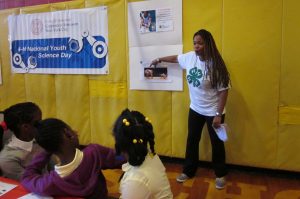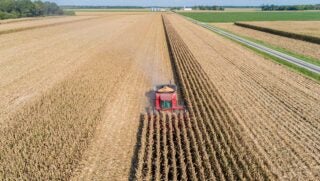There’s not much call for the meat judging team in Manhattan, but kids here should learn how to take soil samples. Maybe if they had, when volunteer melons started growing in the median of Broadway this summer, people would have known whether it was safe to eat them.
In a city where 80 percent of the ground is covered by asphalt, it’s easy to ask whether agricultural programs like FFA or 4-H have a place. In farming terms, Manhattan is small — just 14,528 acres — but with 1.64 million people living on it, you’d think the island was all-encompassing. Few here could grow their own food, if not from lack of knowledge than of space. At the farmers’ market, “local” peaches from Pennsylvania sell for $3 each. New Yorkers buy them without thinking — never mind if they’re ripe. Like other talents rural residents take for granted, knowing what’s in season is not a life skill in the city. How could it be? Asphalt and people are everywhere.
Of these 1.64 million — plus the 7 million more living in New York’s other boroughs, last year, only 1,135 youth were in 4-H. An additional 3,964 took part in activities like Farmers’ Market Nutrition Education and Tech Wizards Mentoring, a program that teaches website development, video production, GIS/GPS technology, and robotics. It’s a far cry from record books and bottle calves.
“Urbanizing” 4-H has been on the uptick since the 1960s, when Urban Extension 4-H Programs partnered with the Expanded Food and Nutrition Education Program to bring educational television programming to minority youth. I grew up in Kentucky in the 1980s and the only non-ag activities our club engaged in were Communications Day, an annual variety show, and a rigorous education in Robert’s Rules of Order. Even demonstrations and talent acts were steeped in rural culture as 4Hers spoke on how to harvest tobacco or performed skits that were set on a farm. The H’s stand for head, heart, hands, and health, but what were our hands for if not growing food and what was a heart if not to love the calf that depended on you?
Without that agricultural component, what makes 4-H different from YMCA or the Boy Scouts? In a 2013 report defending city programs, the 4-H Urban Task Force Programs Committee wrote, “Urban 4-H programs often target audiences where they live in high-need, low-resource locations, e.g., after-school classrooms, community youth centers, housing developments, schools, and churches.” As I read this, “where they live” stands out. From the outside, New York may look like nothing but asphalt and skyline. But for 1,135 4-Hers, this is their community, their country, and their world.

In an increasingly urban society, the future of 4-H depends on how well we remember its past. In the late 1800s, according to the National 4-H History Preservation Program, “researchers found that young people were open to new thinking and would ‘experiment’ with new ideas and share their experiences and successes with their parents. In this way, rural youth programs became an innovative way to introduce new agriculture technology to their communities.” In a world where computer vision sorts coffee cherries and robots harvest apples, programs like Tech Wizards may not be that far removed after all.
In a city where only 20 percent of the soil can be seen, with enough tech knowledge, maybe a Manhattan 4-Her will one day pledge her head and heart to finding innovative solutions for the world’s growing food shortage. This is New York after all: To (mis)quote Frank Sinatra, if you can grow it here, you can grow it anywhere.
I would caution urban 4-H programs not to lose complete sight of the program’s agricultural roots, though. FFA faces similar challenges, but has always taken care never to take the “agri” out of “business” as the organization adapts to a changing world. Manhattan youth may not be in a position to raise cows or judge meat, but someone has to tend the police horses in Central Park. In addition to learning code, clubs should cultivate rooftop gardens and get the facts on those volunteer street melons. We don’t have a lot of land up here, but as long as there’s ground enough for both plants and ideas to grow, there’s room for 4-H.



